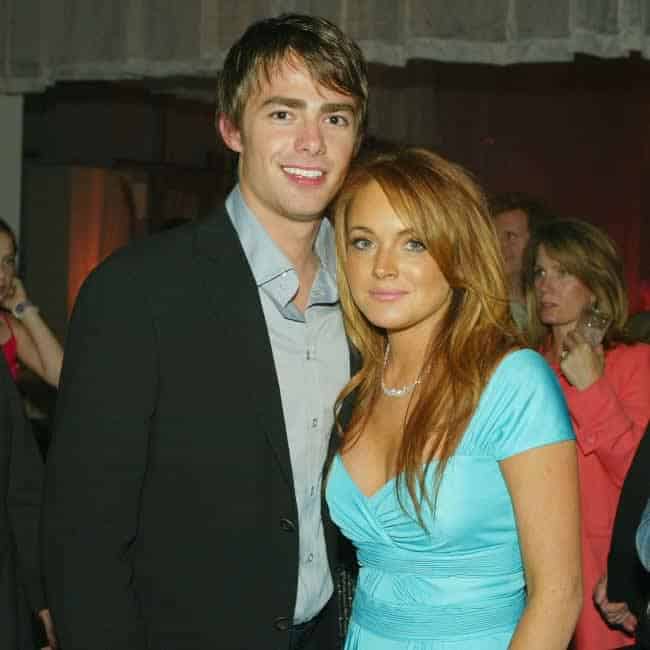
About six months ago I stopped eating meat. I was teaching a graduate course at UCLA that investigated how Italian Renaissance writers conveyed their concepts about the human through writing about the nonhuman – plants, animals, objects, angels, demons, gods and God. As weeks passed, I found myself becoming more and more attuned to the nonhuman entities all around me, more aware of their vibrant lives. Cutting flowers for a short-lived bouquet seemed wrong; chewing on animal flesh became flat out impossible.
Leonardo da Vinci was one of the authors we were studying in the course. Out of the thousands of pages comprising his 25 documented codices, known collectively as his “Notebooks,” we read passages describing the natural world and its inhabitants, and some of his philosophical maxims, fables and riddles. In a striking passage that introduces his “Treatise on Water,” he wrote:
“By the ancients man has been called the world in miniature; and certainly this name is well bestowed, because, inasmuch as man is composed of earth, water, air, and fire, his body resembles that of the earth; and as man has in him bones — the supports and framework of his flesh —, the world has its rocks — the supports of the earth; as man has in him a pool of blood in which the lungs rise and fall in breathing, so the body of the earth has its ocean tide which likewise rises and falls … ”
Unlike many thinkers of his time who anthropomorphized the Earth, Leonardo terramorphized man. But it was not just man that Leonardo saw as a Platonic microcosmic-world-in-miniature. Animals, he wrote, are “the image of the world.” They reflect the Earth, just as we do.
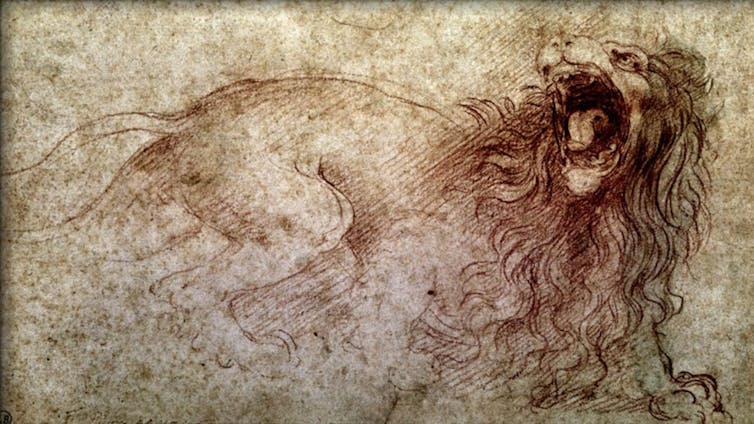
Humans not superior to animal world
Leonardo never challenged the Christian belief that human beings were made in the image of God, nor the classical notion that man's proportions and symmetries (albeit a white, middle-aged, able-bodied, European man) were beautiful and worthy of imitation in architecture and art. But he also never claimed other living beings were less beautiful, soulless, or lacked intelligence.
When comparing animals and humans – which he did often – animals often came out looking better. In one of his notes, Leonardo wrote, “Man has much power of discourse, which for the most part is vain and false; animals have but little, but it is useful and true, and a small truth is better than a great lie.” He often pointed out how much more powerful animals' senses were, how much faster, stronger, more efficient and capable they were of performing remarkable feats, such as flight.
And animals were not nearly as “bestial” to one another as humans could be. “King of the animals – as thou hast described him – I should rather say king of the beasts,” he wrote. Leonardo lamented how human stomachs have become “a sepulcher for all animals” and how “our life is made by the death of others.”
Leonardo the vegetarian?
This passage, along with other writing about humans as killing machines and their esophagi as animal cemeteries, as well as a few comments by his contemporaries, have led many to believe that Leonardo was a vegetarian.
There is a 1515/6 letter by the Italian explorer Andrea Corsali to Giuliano de' Medici that – in discussing how the Gujarati of India won't eat anything with blood or allow hurt to come to any animate thing – says they are “like our Leonardo da Vinci.” Corsali, however, did not know Leonardo well, and the sentence is ambiguous; it could just mean that Leonardo never hurt animals or wanted to see them hurt.
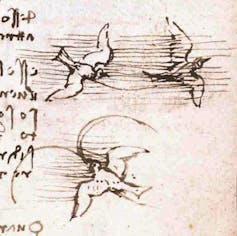
Artist and biographer Giorgio Vasari (1511-1574) noted that Leonardo was famed for buying caged birds and setting them free and Leonardo did, in fact, advocate for eating Nature's abundant senplici (“simples”), a term which seems to imply plant-based recipes. He pondered why Nature had created a world in which animals ate each other, but concluded it was because life is compelled to reproduce and endure, and consequently, Nature needed a way to keep numbers down.
Nowhere in his writing, however, did he speak of not eating meat. His grocery lists have meat on them, although it is possible he was purchasing it for members of his household: students, servants, guests, animals.
Whether he ate a totally meat-free diet or not is unclear, but his love for animals is unquestionable. He lived with animals on a farm as a child and they were ever-present in his studio – likely cats and dogs, insects, birds and reptiles (some alive, some deceased). Leonardo studied them, depicted them, wrote about them and built machines – even war machines – inspired by them.
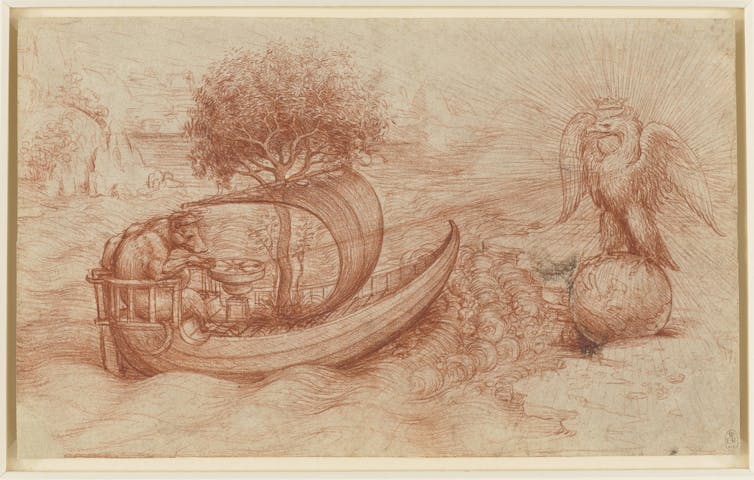
Literary animals
Leonardo's literary writing – fables, riddles, aphorisms – is filled with animals. While they often serve as Aesopic moral stand-ins for humans, Leonardo also used them differently than other classical, medieval and Renaissance fabulists, contrasting them to humans, celebrating their strengths and wisdom and critiquing how humans treat them.
In his “Prophecy” riddles — which read like predictions of a horrendous apocalyptic future — one encounters legions of cruelty and pain. “I see children of thine given up to slavery to others … paid with the severest suffering, and spend[ing] their whole life benefiting those who ill treat them.” As a riddle, this is not what it seems. He's writing not of humans, but rather, of donkeys, and how humans repay their services with unkindness and even violence. That said, in an empathic move, Leonardo was also linking humans to donkeys, and pointing to the ever-present fact that humans subject other humans to terrible fates.
In another riddle he noted the twistedness of horned animals being slaughtered by horn-handled knives, and the ostensible cannibalism of masters of estates “eating their own laborers” – oxen.
And in a particularly chilling prophecy, he described animals so full of evil that they were destroying all life on land and sea: He cries, “O Earth! Why dost thou not open and engulf [these animals] in the fissure of thy vast abyss and caverns, and no longer display in the sight of heaven such a cruel and horrible monster!” The monster, of course, is man.
Although many people assume Leonardo's Vitruvian Man is an indication of an adherence to the commonly, but not universally, held Renaissance notion that man was the most perfect of beings and “the measure of all things,” his literary and artistic production seem to show that he saw animals as the true “image of the world.” While he included human beings in the group he called “animals,” it was not as preeminent entities, but as one of the world's infinite, beautiful varieties.
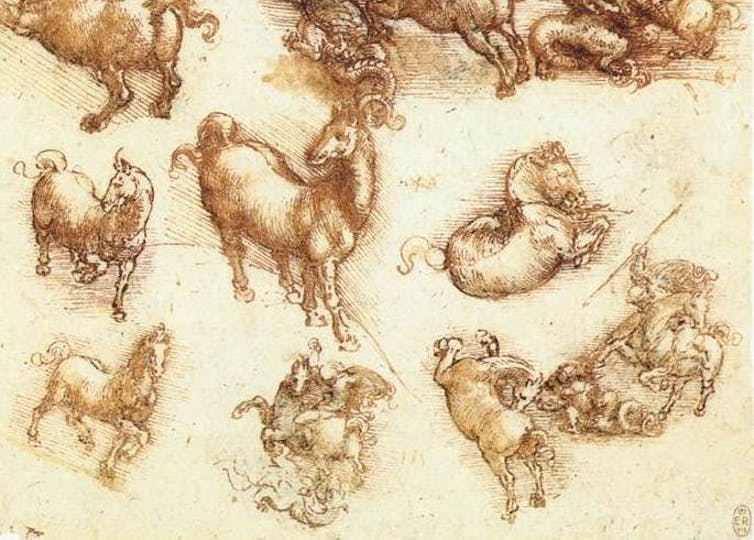
Animals on their own terms
Animals proliferate in Leonardo's visual art. In his sketches we see horses run, trot, rear up on back legs, fall. Birds, bats and insects extend their wings. Cats stretch, wrestle and lounge. Lions roar. Bears, dogs, crabs, rhinoceroses quietly stand or walk. Beetles and ants bend their appendages.
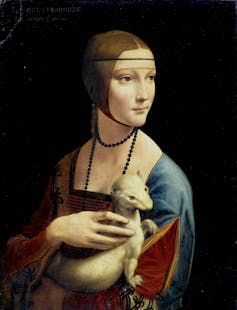
His animals are anything but nature-morte; they are alive with motion and, seemingly, emotion. Within his paintings one can see, for example, a gentle, communicative lion in the unfinished “Saint Jerome in the Wilderness” (c. 1480); an affectionate ermine in “Lady with an Ermine” (1489-90); an erotic swan in the 1503-1507 sketches for a never-produced painting, “Leda and the Swan”); a lamb being hugged by the child Jesus in “The Virgin and the Child with Saint Anne” (1510). And, of course, horses: ceremonial and military (“The Adoration of the Magi” (1481), “The Battle of Anghiari” (preparatory studies, 1504-1505).
All these animals are present in his writing, too, joined by an ark-load more: domesticated, wild, local, exotic, mythical (dragons!) and imaginary (sea-monsters!). Leonardo's depictions of animals emerge not only as forces that teach us about ourselves and challenge our sense of human primacy, but as powerful, creative forces, on their own terms.
Leonardo chipped away at the walls between “us” and “them” by placing all life on a level field, all things as micro-reflections of a macro-whole. And as he envisioned in his terrifying visual and verbal depictions of catastrophic deluges and global disasters, we're all in this together.![]()
Arielle Saiber, Professor of Romance Languages and Literatures, Bowdoin College
This article is republished from The Conversation under a Creative Commons license. Read the original article.


